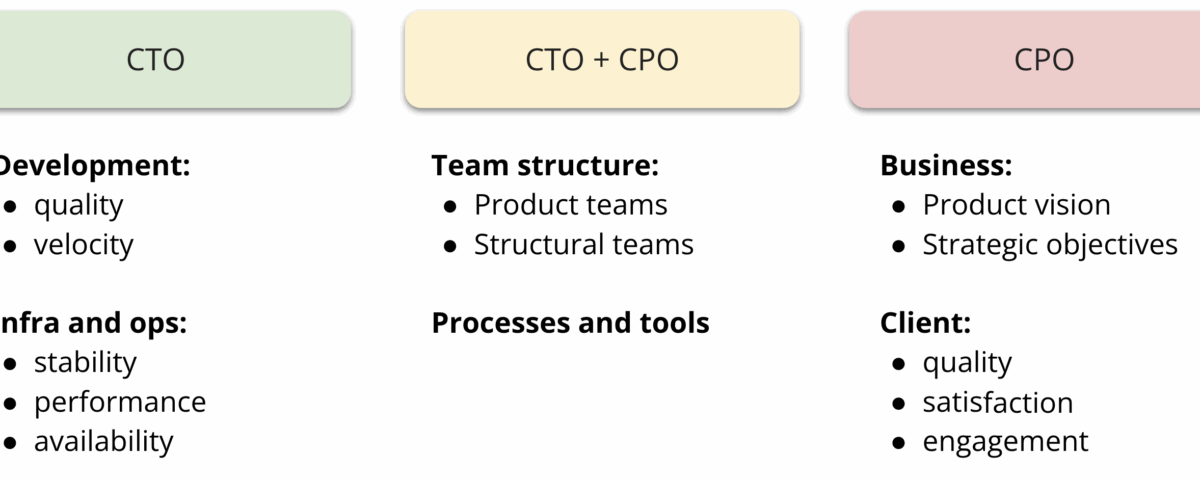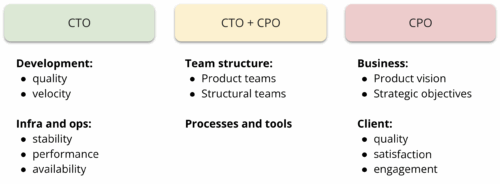
Downsizing and layoffs
18 de November, 2025The product development area is a single entity with the common goal of creating the best product to meet the company’s strategic objectives while solving problems and addressing customer needs. Having two or more leadership roles for this area requires significant coordination to ensure that teams are collaborating and progressing in the same direction. The most common way to divide this leadership is to have two individuals, a Chief Product Officer (CPO) and a Chief Technology Officer (CTO), to lead the product development team. While the CPO leads product and UX teams, the CTO leads engineering teams.
This image illustrates the responsibilities of each leadership role. The CTO takes care of the actual development of the product, focusing on the quality and speed of development. They also handle infrastructure and operational issues, such as product stability, performance, and availability. The CPO oversees the product from both a business and customer perspective. From a business standpoint, they are responsible for defining the product vision aligned with the business’s strategic objectives. From a customer perspective, they need to ensure that the product effectively solves a customer’s problem or need with quality, requiring an understanding of customer satisfaction and engagement with the product.
Collaboratively, the CTO and CPO must define and evolve the structure of the product development team, including product teams and structural teams (SRE, Data, etc.), as well as establish and improve the processes that this team will use in their day-to-day operations.
Single leadership or shared leadership?
Both at Locaweb and Conta Azul, I held the role of CPO with the responsibility of leading the entire product development team, consisting of product managers, product designers, and engineers. At Lopes, I led the entire Lopes Labs, a technology and innovation team that included engineering, design, product, and marketing personnel, given that marketing in the real estate industry is predominantly digital.
The single leadership model works well when there are senior individuals to assist in managing engineering, design, and product aspects. At Conta Azul, the team reached 130 people, and I had 1 head of engineering, 4 GPMs, and 1 head of design to support me. At Locaweb, with a team of 100 people, I had 2 senior engineering managers, 5 senior PMs, and 1 head of UX. At Lopes, with a team of 120 people, I had 1 head of marketing, 6 GPMs, and 1 senior engineering manager.
I like this configuration because I have always seen the product development team as a unified entity, with common objectives to deliver the best product to meet the company’s goals while solving user problems and needs. This configuration aids alignment and fosters a sense of a unified team.
This type of configuration works very well for small teams, up to around 80 to 100 people. When it reaches this size, there is a risk of overburdening the single leader responsible for the entire product development team. There are numerous different topics to manage, highlighting the importance of having senior individuals assisting in leadership.
In some companies, instead of a CPO, this single leadership is called Chief Technical Officer (CTO) or Vice President of Product Development.
It might make sense to consider splitting the area into two leadership roles when the team grows beyond 100 people, having a CPO and a CTO in shared leadership. It’s worth noting that shared leadership, while beneficial in terms of dividing responsibilities, can have detrimental side effects if not well managed by the CEO.
At Gympass, we operated for 18 months with a CTO and two CPOs, one focusing on consumer products and myself focusing on products for businesses and partners. We chose this configuration because we anticipated significant team growth. When the team was still at 60 people, we already envisioned growth to 400 people. Being able to share responsibilities, especially when the team grows rapidly to numbers above 100 people, helps give more attention and depth to the specific areas each leader oversees, avoiding the overload mentioned earlier.
At Gympass, the UX team reported to the CPO for consumers, while I had, in addition to the product teams for businesses and partners, a Professional Services (PS) team. This team was responsible for handling customized integrations with the gym systems and HR systems of our clients. The work in professional services is more project-oriented, with a clear definition of scope and well-defined deadlines, which is why we created a separate area to manage these integrations.
When I left Conta Azul in mid-2018, we were starting to consider splitting roles between CTO and CPO. In fact, by 2020, the structure had evolved to have shared leadership of the product development team.
Another possibility for shared leadership of product teams is to have heads for engineering, products, and UX.
Shared leadership has the inherent risk of creating silos, where teams work in isolation without the necessary collaboration. At Gympass, we were strongly concerned about avoiding this behavior. We sat together, the three of us, and dedicated a minimum of 3 hours per week to discuss topics related to the product development team. This included 1 hour among the three leaders, 1 hour with the business partner from HR, and 1 hour with the CEO. Additionally, we aimed to define common objectives for the teams and treated the budget as a unified budget for the product development area.
Despite our efforts, there were still instances of a lack of collaboration among members of different teams. For this reason, I prefer configurations with a single leadership structure for the product development team, despite the potential overload on that leadership. One way to mitigate this overload is to have senior leaders in place.
Digital transformation and product culture
This article is another excerpt from my newest book “Digital transformation and product culture: How to put technology at the center of your company’s strategy“, which I will also make available here on the blog. So far, I have already published here:
- About the book
- Part 1: Concepts
- Chapter 1: The so-called digital transformation – Project and Product
- Chapter 2: Uncertainty and digital transformation
- Chapter 3: Types of company
- Chapter 4: Type of company vs digital maturity
- Chapter 5: Business models
- Chapter 6: Agile, digital and product culture
- Part 2: Principles
- Chapter 7: Deliver early and often – Measuring and managing the productivity – Case study: Dasa Group – Case study: Itaú Unibanco
- Chapter 8: Focus on the problem – O Famoso Discovery de Produto – Why the “business demands => IT implements” model does not work – Case study: Magazine Luiza
- Chapter 9: Result delivery – Outsource or internal team? – Case study: Centauro
- Chapter 10: Ecosystem mindset
- Part 3: Tools
- Chapter 11: Product Vision – Product vision examples
- Chapter 12: Product Strategy
- Chapter 13: Team Structure – Structuring effective product development teams – Structural teams – Team structure spreadsheet – Downsizing and layoffs – CTO + CPO
Workshops, coaching, and advisory services
I’ve been helping companies and their leaders (CPOs, heads of product, CTOs, CEOs, tech founders, and heads of digital transformation) bridge the gap between business and technology through workshops, coaching, and advisory services on product management and digital transformation.
Gyaco Podcasts
At Gyaco, we believe in the power of conversations to spark reflection and learning. That’s why we have three podcasts that explore the world of product management from different angles:
- Produto em Pauta: In the new season, titled “Beyond the Buzzwords”, Felipe Castro and I demystify product terms with real examples from our clients. Available on YouTube and Spotify. Recorded in Portuguese, with English subtitles on YouTube.
- Product Chronicles, the Brazilian Way: with Fábio Martinelli Duarte and Paulo Caroli — the Brazilian way of building products: stories, challenges, and lessons learned, featuring case studies from our clients. Available on YouTube and Spotify. Recorded in English, with Portuguese subtitles on YouTube.
- Beyond the Article, Expanded by AI: C.L.A.R.A. (Creative Language AI for Reflective Augmentation) chats with my AI clone, JocAI, expanding on my articles with new perspectives. Available on YouTube and Spotify. Thanks to AI, episodes are available in English, Spanish, and Portuguese.
Digital Product Management Books
Do you work with digital products? Do you want to know more about managing a digital product to increase its chances of success, solve its user’s problems, and achieve the company objectives? Check out my Digital Product Management books, where I share what I learned during my 30+ years of experience in creating and managing digital products:
- Digital transformation and product culture: How to put technology at the center of your company’s strategy
- Leading Product Development: The art and science of managing product teams
- Product Management: How to increase the chances of success of your digital product
- Startup Guide: How startups and established companies can create profitable digital products





